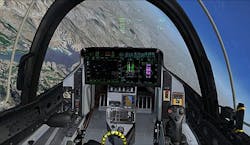Military avionics market to drop 1.3 percent in 5 years due to dwindling numbers of new aircraft
MOUNTAIN VIEW, Calif., 29 Nov. 2012. The North American military avionics market will decline 1.3 percent over the next five years, dropping from 13.48 billion in 2011 to $13.31 billion in 2017, predict analysts at market researcher Frost & Sullivan in Mountain View, Calif.
"Past programs often involved completely new aircraft and avionics designs. The relatively small numbers of new aircraft models will limit the number of market participants able to play a role in the development and manufacture of those aircraft," explains Frost & Sullivan Industry Manager Wayne Plucker.
The noted market analyst firm made its predictions in a new report entitled North American Military Avionics Market, which establishes the current and expected spending for avionics in the U.S. and Canada. The report segments military avionics spending by type of aircraft, by military service budget category and by type of avionics.
Most new military avionics programs rely on common airframes modified for specific missions, Frost & Sullivan analysts say. Some of these airframes are commercial aircraft designs and use largely commercial avionics for flight avionics. Integrated avionics, however, will offer new opportunities for niche suppliers.
Overall, the total number of suppliers in the avionics market has been declining due to mergers and acquisitions, yet some industry consolidations actually have enhanced competition.
Aircraft manufacturers are pursuing opportunities as avionics integrators, while component suppliers who supplied stand-alone systems in the past are providing integrated solutions, analysts say.
"Boeing and Lockheed Martin are accruing more direct avionics revenue, and Northrop Grumman and Raytheon are now major market participants," Plucker says. "Aircraft programs are becoming more international, resulting in increasing competition for roles in the few new aircraft programs."
For more information contact Frost & Sullivan online at www.defense.frost.com.

